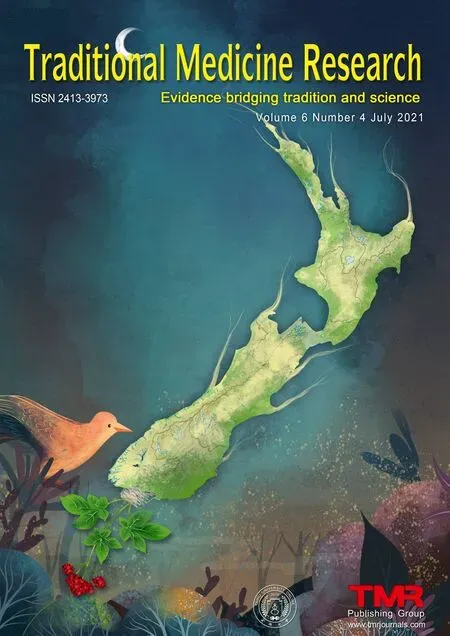Traditional Chinese medicine of Salvia miltiorrhiza Bunge:a review of phytochemistry,pharmacology and pharmacokinetics
2021-07-07EbukaOlisaemekaNwaforPengLuJiaWeiLiQingQingZhangDongLiQiZhiDongLiuHuiPengHuanQinYanQuanGaoJiLinWang
Ebuka-Olisaemeka Nwafor ,Peng Lu ,Jia-Wei Li,Qing-Qing Zhang,Dong-Li Qi,Zhi-Dong Liu*,Hui Peng,Huan Qin,Yan-Quan Gao,Ji-Lin Wang
1State Key Laboratory of Component-Based Chinese Medicine,Tianjin University of Traditional Chinese Medicine,Tianjin 301617,China;2Engineering Research Center of Modern Chinese Medicine Discovery and Preparation Technique,Ministry of Education,Tianjin 301617,China;3College of Chinese Medicine,Tianjin University of Traditional Chinese Medicine,Tianjin 301617,China.
Abstract Salvia miltiorrhiza Bunge,known as red sage or Danshen,is commonly applied in Chinese herbal therapeutics for various biological effects.In 25-220 C.E.,the earliest Chinese Materia Medica referred to as Shengong’s Classic of Materia Medica(Eastern Han Dynasty of China,200 C.E.)initially documented Salvia miltiorrhiza Bunge.Currently,Salvia miltiorrhiza Bunge is one of the most frequently prescribed traditional Chinese medicines in clinics for antidiabetic,antianxiety,antihypertensive,antidepressant,antilipidemic,antiarrhythmic,and anticancer effects.Undoubtedly,it is best known for improving and promoting blood circulation;thus,its recommendation for use in cardiovascular disorders.Regarding this article,important information was sourced both manually and electronically using patent compendium and databases,including Google Scholar,herbal plant monographs,Hindawi,PubMed,Embase,CNKI,pharmacopoeias,Springer,etc.Well-concise details and discussions on the botany,traditional medicinal uses,chemical constituents-phytochemistry,pharmacokinetics,pharmacology,and toxicology information are presented.In perspective,understanding the comprehensive information of the above-stated fields with regards to Salvia miltiorrhiza Bunge would yield an additional positive knowledge on areas that need urgent attention and identify gaps in research and safety for future consideration.
Keywords:Traditional medicinal uses,Salvia miltiorrhiza Bunge,Phytochemistry,Toxicology,Quality control,Pharmacology
Background
Salvia miltiorrhizaBunge(SMB),recognized as Danshen,is a Chinese herb that usually grows to about 30-100 centimeters.The herb consists of the stem,leaves embedded by whitish pubescence,branches,long and thin roots(i.e.,cylindrical)shielded by earthy red skin,and glandular hairs with yellowish pubescence.Its primary health benefits comprise of enhancing body function and promoting blood circulation[1-5].Thus,traditionally it serves as a remedy for different diseases such as cerebrovascular hemorrhage, edema, malignancy, menstrual abnormalities,insomnia,liver disorders,anxiety,miscarriage,and cardiovascular-related conditions[4,6-14].Various forms of SMB regimen produced pharmaceutically exist as sprays,injectables,tablets,granules,oral liquids,capsules,and dripping pills.Additionally,numerous modern dosage forms,namely liposomes,dispersion of solid,and fast soluble tablets of SMB,have been investigated.
The earliest Chinese Materia Medica referred to asShengong’s Classic of Materia Medica(completed around Qin and Han Dynasty of China,262-202 B.C.E.)initially documented SMB[15].Earlier 3rdcentury C.E.,the medical practitioner-Wupu recommended that SMB treat abdominal and chest inflammation in his book titledWupu’s Materia Medicafinished in Wei Dynasty[16].In 1578,TheCompendium of Materia Medica,a Chinese herbology volume written by Li Shizhen during the Ming Dynasty,also kept a concise document on SMB clinical characters and morphologies[17].Based on the purported relevance of SMB in the management of chronic disorders,its extensive use is not limited to only China but other countries,especially countries within the Asian continent.In 2008-2017,Food and Drug Administration(FDA)in China and other Asian countries recommended SMB therapy for peripheral arterial disease with intermittent claudication and acute mountain sickness[18,19].The utilization of SMB in China annually is more than 16 million kilograms,thereby posing great economic usefulness besides its clinical benefits.In China,amidst all the available SMB drug forms,the Fufang Danshen table and dripping pill(approved drug number by China FDA:Z20083347,Z10950111)are commonly applied remedies and recorded inChinese Pharmacopeia[20,21].Several countries like Saudi Arabia,Russia,Republic of Korea,Vietnam,and Cuba have Fufang Danshen dripping pill as a registered drug or medication based on China FDA recommendation.Due to herbal products’prejudice universally regarding their therapeutic properties,safety,and efficacy,this review comprehensively discusses the botanical,traditional medicinal uses,components or constituents, phytochemistry, pharmacology,pharmacokinetics,toxicology,efficacy,safety,and quality control assessment properties of SMB.
Botany
SMB is a perennial plant or herb native to China and Japan that predominantly germinates efficiently on a draining soil and under sunlight.It is situated between 100-1,300 m of the forest,hillsides,or streamsides of Hubei,Jiangsu,Henan,Shandong,Hunan,Shanxi,Hebei,Zhejiang,and Anhui in China[22,23].This herb is characterized by taproot,branches,leaves,stem,petiolule,leaflets,pedicels,inflorescences,and calyx campanulate[24].The distribution of SMB in China occurs in more than 15 provinces and is influenced by geographical location,ecological or climatic factors(the type of soil,temperature,water,pressure,precipitation,humidity,and light)[25,26].Nonetheless,SMB distribution and attributes are depicted in Table 1,whereas the whole plant and processed medicinal parts of SMB are shown below(Figure 1).
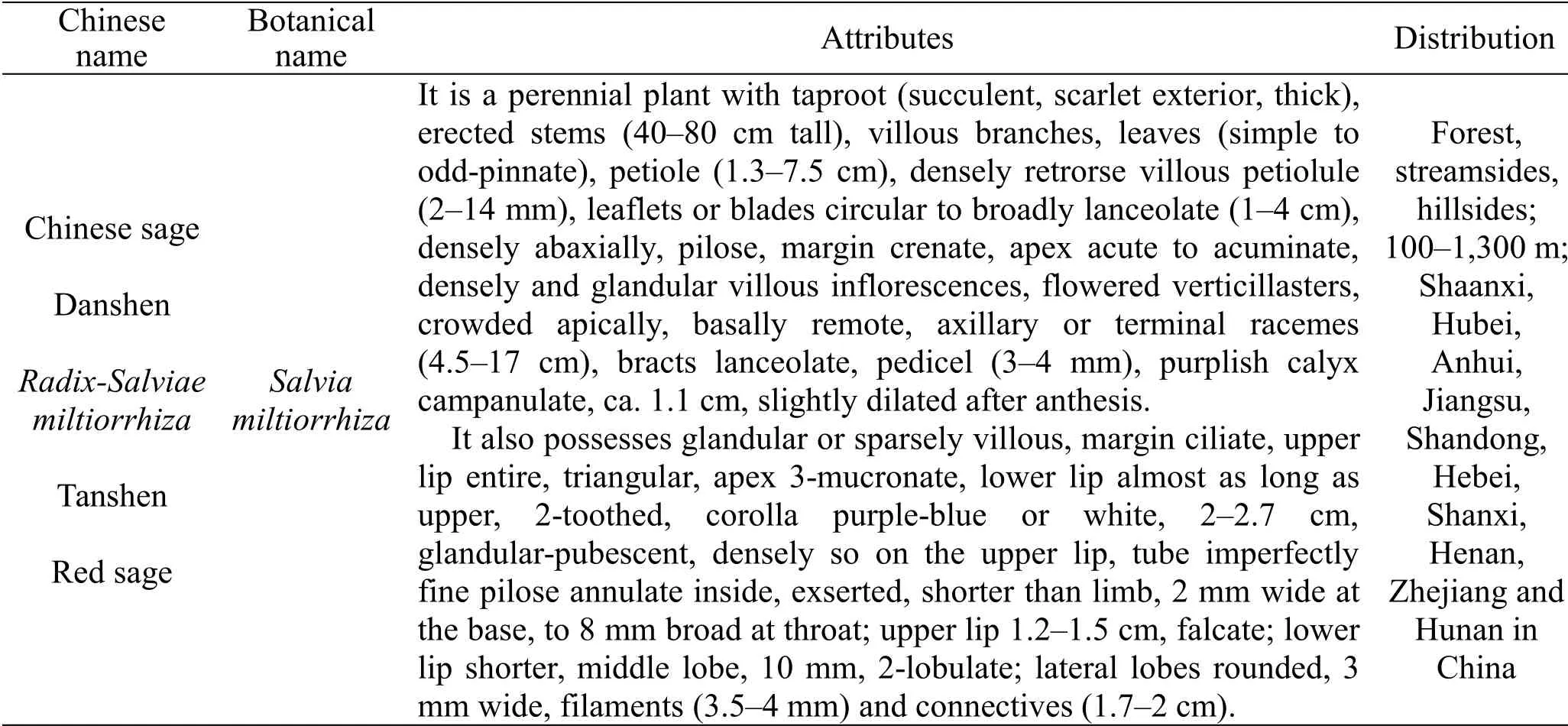
Table 1 Attributes and distribution of SMB
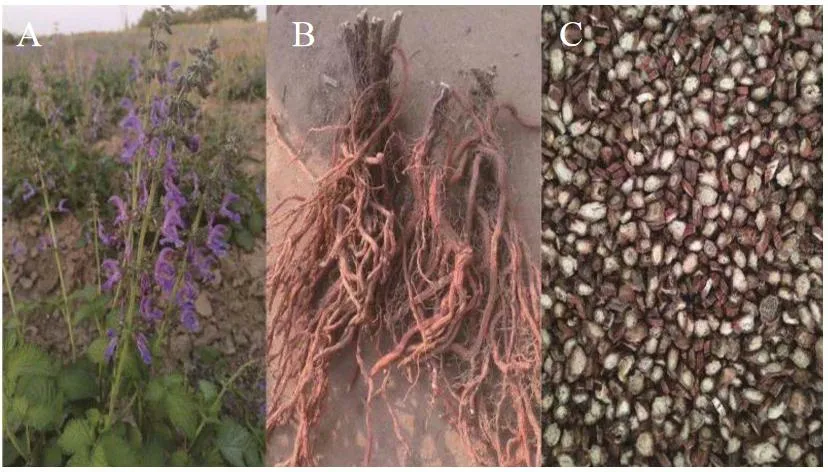
Figure 1 Whole plant of SMB(A),medicinal parts of SMB(B),and processed portions of SMB(C).SMB,Salvia miltiorrhiza Bunge.
Phytochemistry
For more than 200 decades,SMB components have been in existence.The evaluation in the early 1930s was predominantly emphasized on its fat-soluble compounds.However,contemporary analysis has concentrated more on its water-soluble compounds,in which not less than 50 constituents were isolated and identified from aqueous extracts.Exceedingly about 80 lipophilic compounds,particularly diterpenes,have been isolated,recognized,and reported from SMB.The diterpenoid compounds possess 20 organized carbon core structure in rings,a group remarkable of SMB bioactive constituents.These constituents have heterogeneous actions,namely,anti-inflammatory,anti-bacterial,antineoplastic,and antioxidative.Furthermore,the diterpenoid categorization of SMB can be divided into two sub-divisions concerning its structural attributes: tanshinones (possess ortho-naphthoquinone chromophore)and abietane or royleanones (possess para-naphthoquinone chromophore).Besides the constituents of diterpenes,chinones have also been derived from SMB[27].
The lipophilic ingredients comprise of methyl tanshinonate, tanshinone I, tanshinone IIB,cryptotanshinone, miltirone, tanshinone IIA,przewaquinone A,1,salvilenone,sclareol,salviolone,tanshinlactone,saprorthoquinone,neocryptotanshinone II,danshenol A,danshenxinkun B,danshenol B,miltirone,sugiol,ferruginol,dihydroisotanshinone I,methylenedihydrotanshinquinone, tanshindiol C,neocryptotanshinone,tanshindiol B,isotanshinone IIA,tanshindiol A, formyltanshinone, arucadiol,epi-cryptoacetalide,microstegiol,salvianan,and isotanshinone II.The most pharmacological examined ingredients are cryptotanshinone and tanshinone IIA[28,29].
In the 1980s,the curative potency of hydrophilic ingredients in SMB was brought to recognition by medical practitioners from Japan and China,who carried out analytical studies on these components.About 15-20 hydrophilic ingredients,mostly phenolic acids(categorized into single/simple and polyphenolic acids)and analogous compounds,have been isolated and identified from SMB extracts.The biological actions of hydrophilic constituents include anti-coagulation,etc.Its examples consist of protocatechuic aldehyde,salvianolic acid(A,B,C,and D),protocatechuic acid,danshensu,ailanthoidol,ferulic acid,lithospermic acid,caffeic acid,isoferulic acid,magnesium lithospermate B,methyl rosmarinate,rosmarinic acid,and lithospermic acid B[30,31].
Besides the diterpene and phenolic acids compounds,additional SMB isolated compounds or ingredients include amino-acids (isoleucine, histidine,phenylalanine,aspartic acid,valine,alanine,luteolin,threonine,glutamic acid,arginine,etc.),ethyl acetate,essential oils,daucosterol,baicalin,ursolic acid,uvaol,vitamin E,aluminum,stachyose,shanzhiside methyl ester,saccharose,manool,palmitic acid,fructose,hexadecane, octadecanol, borneol acetate,hexadecanoic acid,tetradecanoic acid,copaene,linoleic acid, tricosane, ledol, pentacosane,heptacosane,isocaryophyllene,nonacosane and spathulenol[2,32,33].Tables 2 to 4 show the isolated compounds’molecular formula,extraction source,mass,and chemical structures.
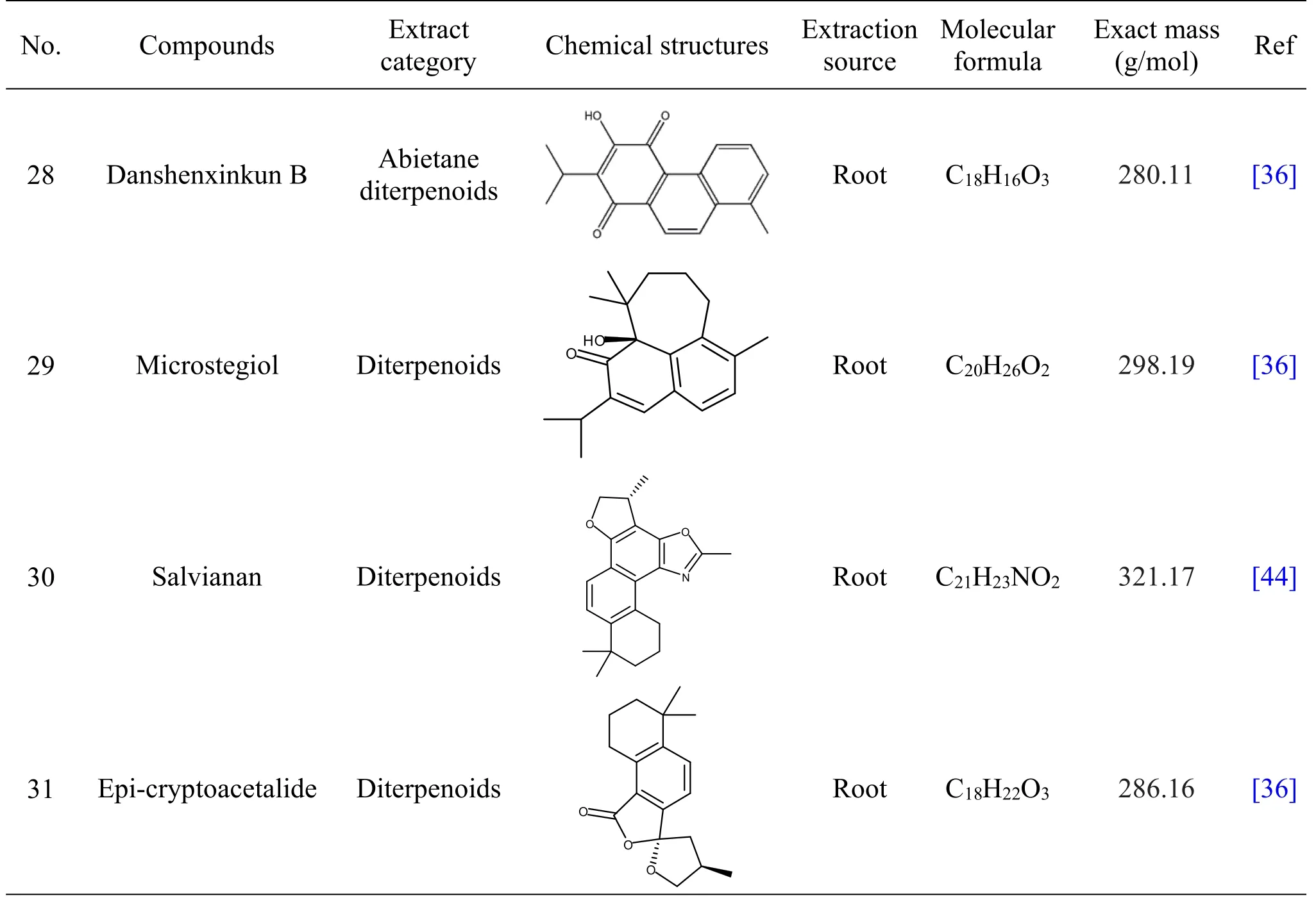
Table 2 Chemical constituents of the lipophilic(fat-soluble)compounds from SMB.(Continued)
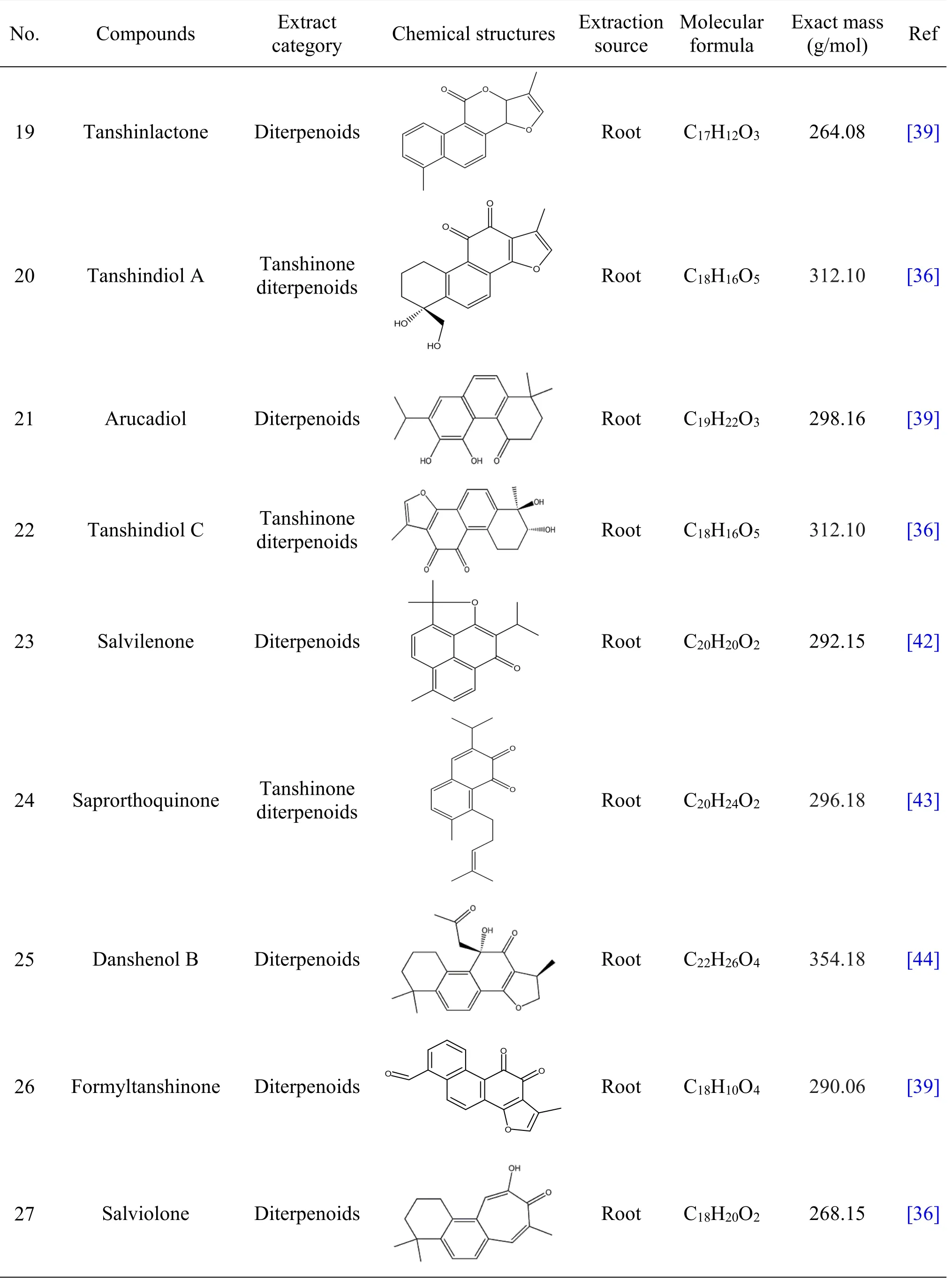
Table 2 Chemical constituents of the lipophilic(fat-soluble)compounds from SMB.(Continued)
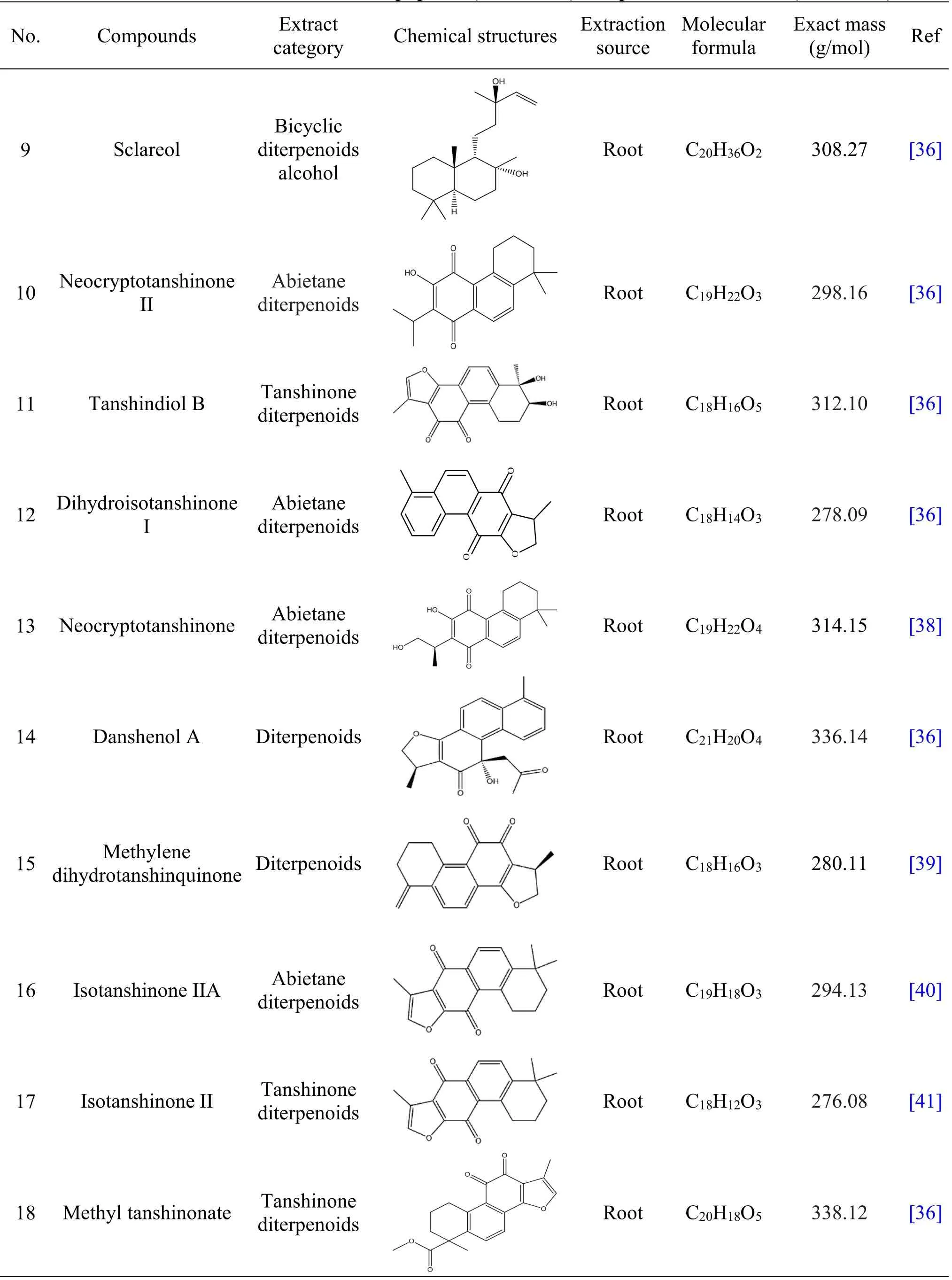
Table 2 Chemical constituents of the lipophilic(fat-soluble)compounds from SMB.(Continued)
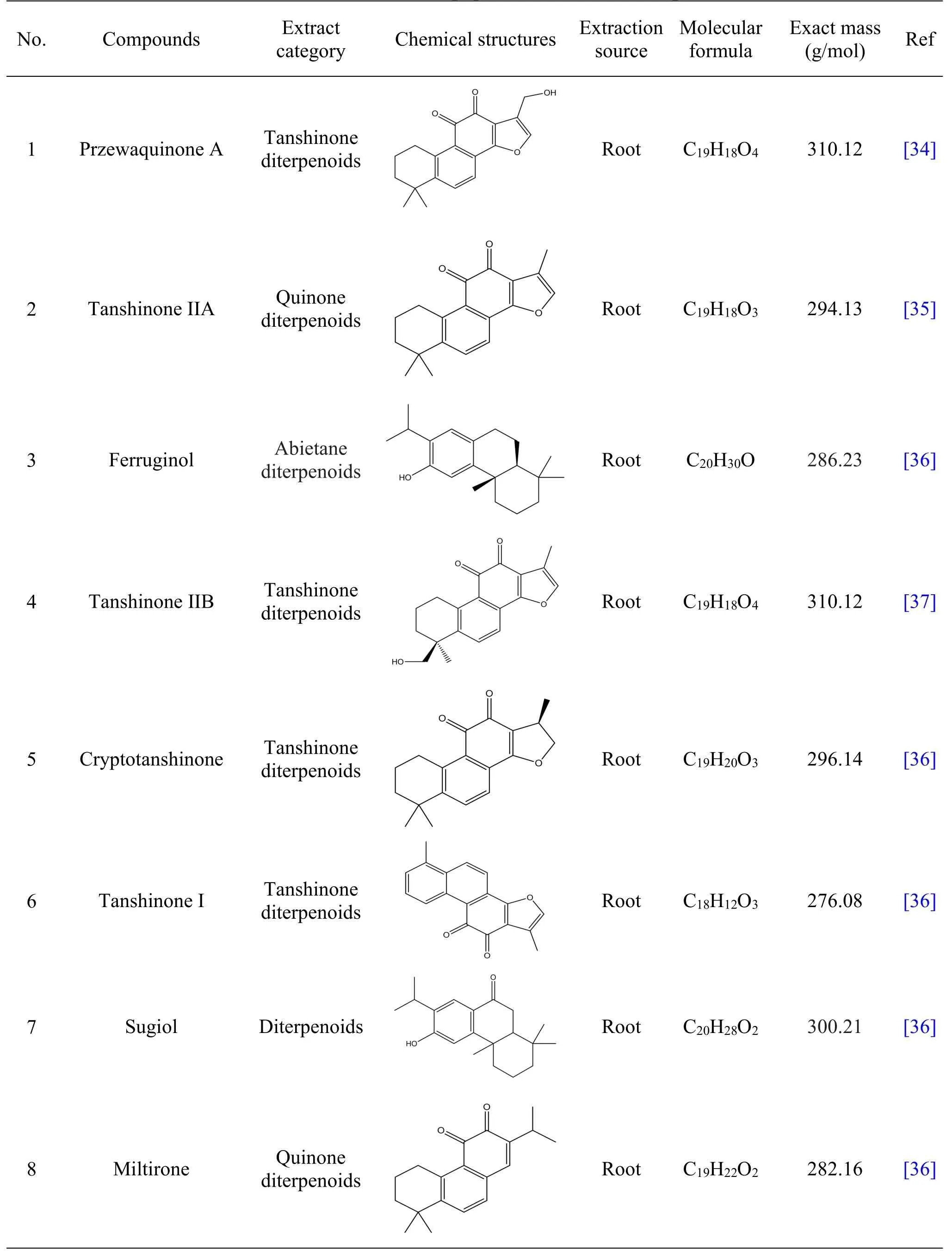
Table 2 Chemical constituents of the lipophilic(fat-soluble)compounds from SMB
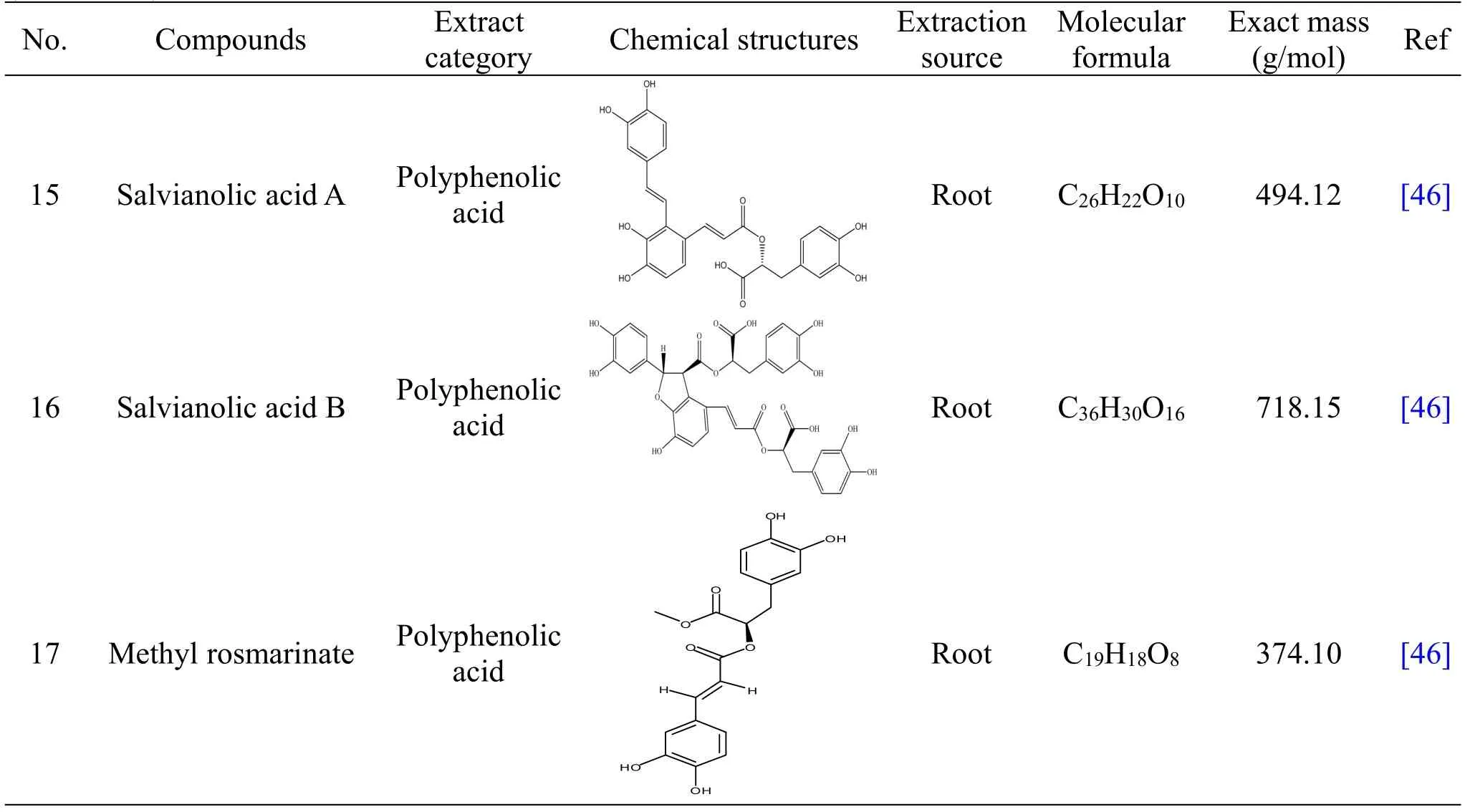
Table 3 Chemical constituents of the hydrophilic or water-soluble(phenolic acids)compounds derived from SMB.(Continued)
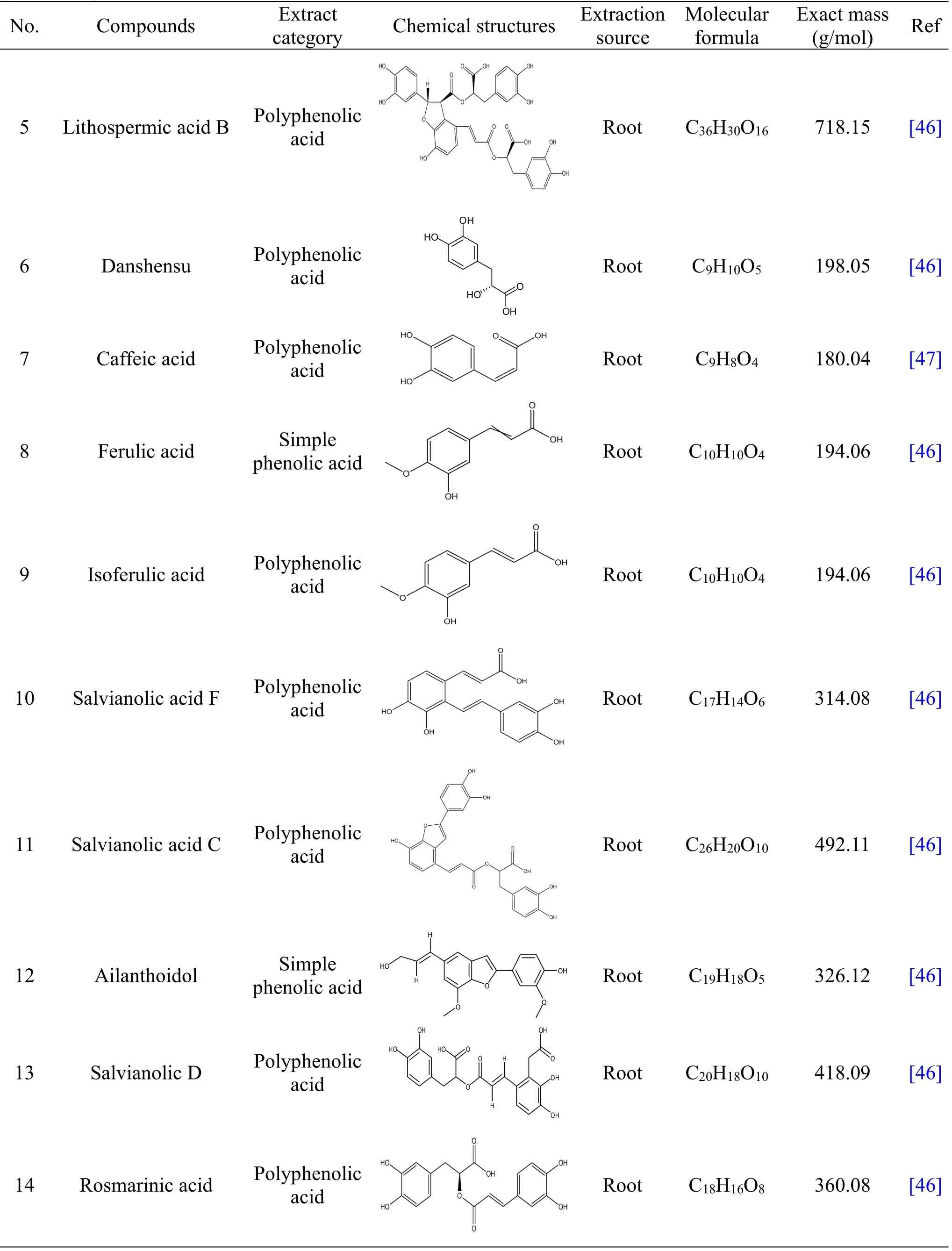
Table 3 Chemical constituents of the hydrophilic or water-soluble(phenolic acids)compounds derived from SMB.(Continued)
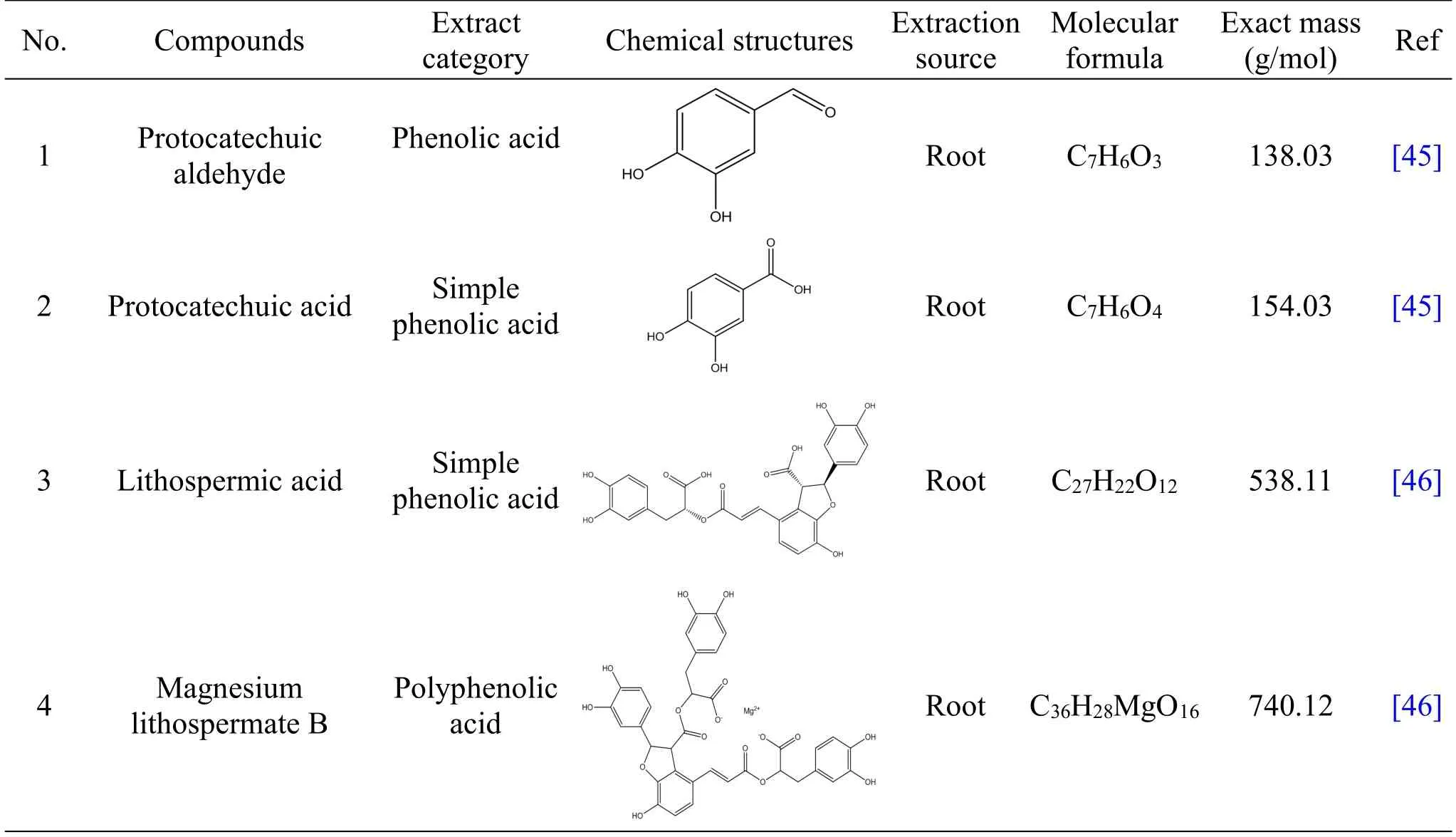
Table 3 Chemical constituents of the hydrophilic or water-soluble(phenolic acids)compounds derived from SMB
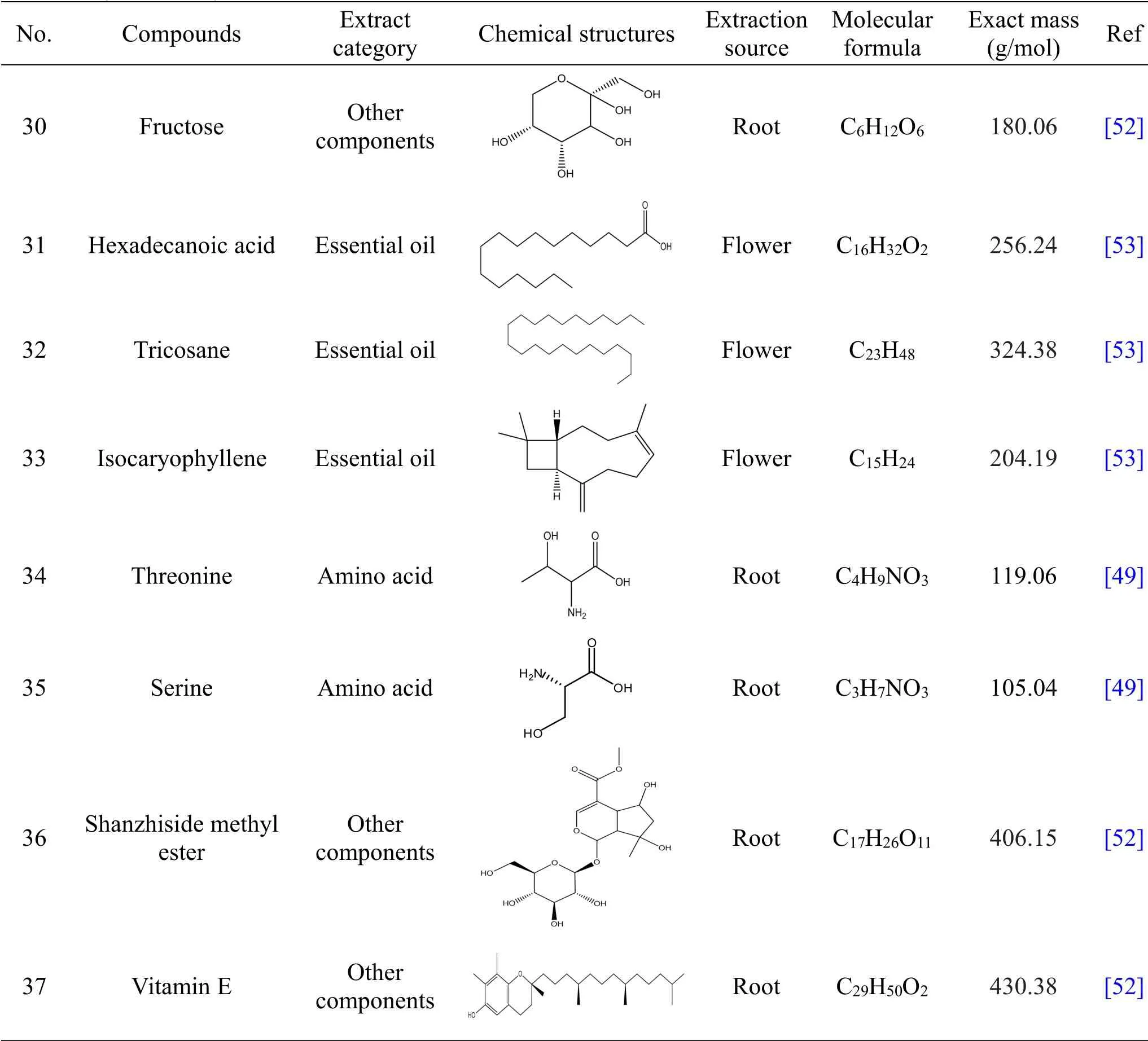
Table 4 Chemical constituents of other compounds(alcohol,essential oils,and ethyl acetate)from SMB extracts.(Continued)
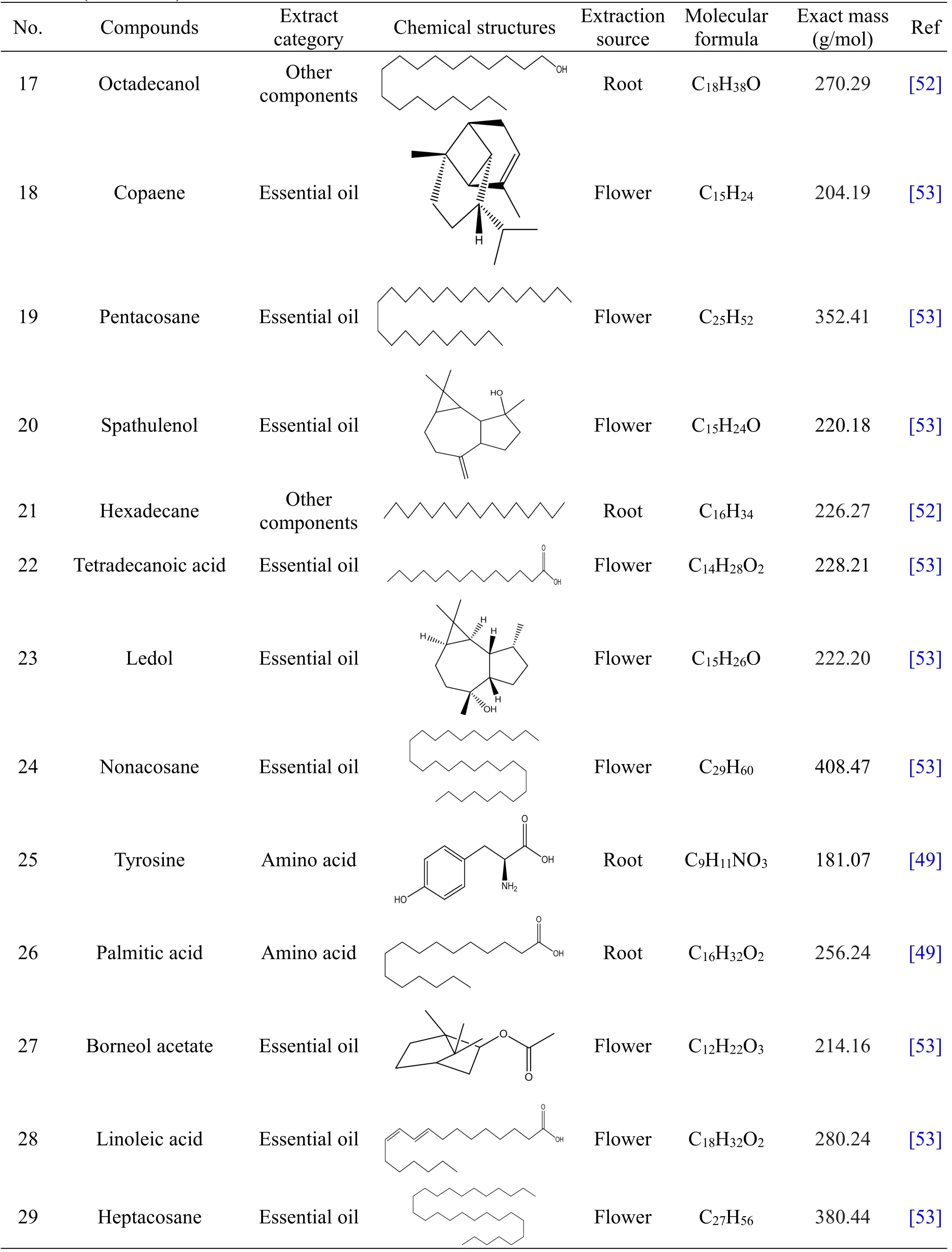
Table 4 Chemical constituents of other compounds(alcohol,essential oils,and ethyl acetate)from SMB extracts.(Continued)
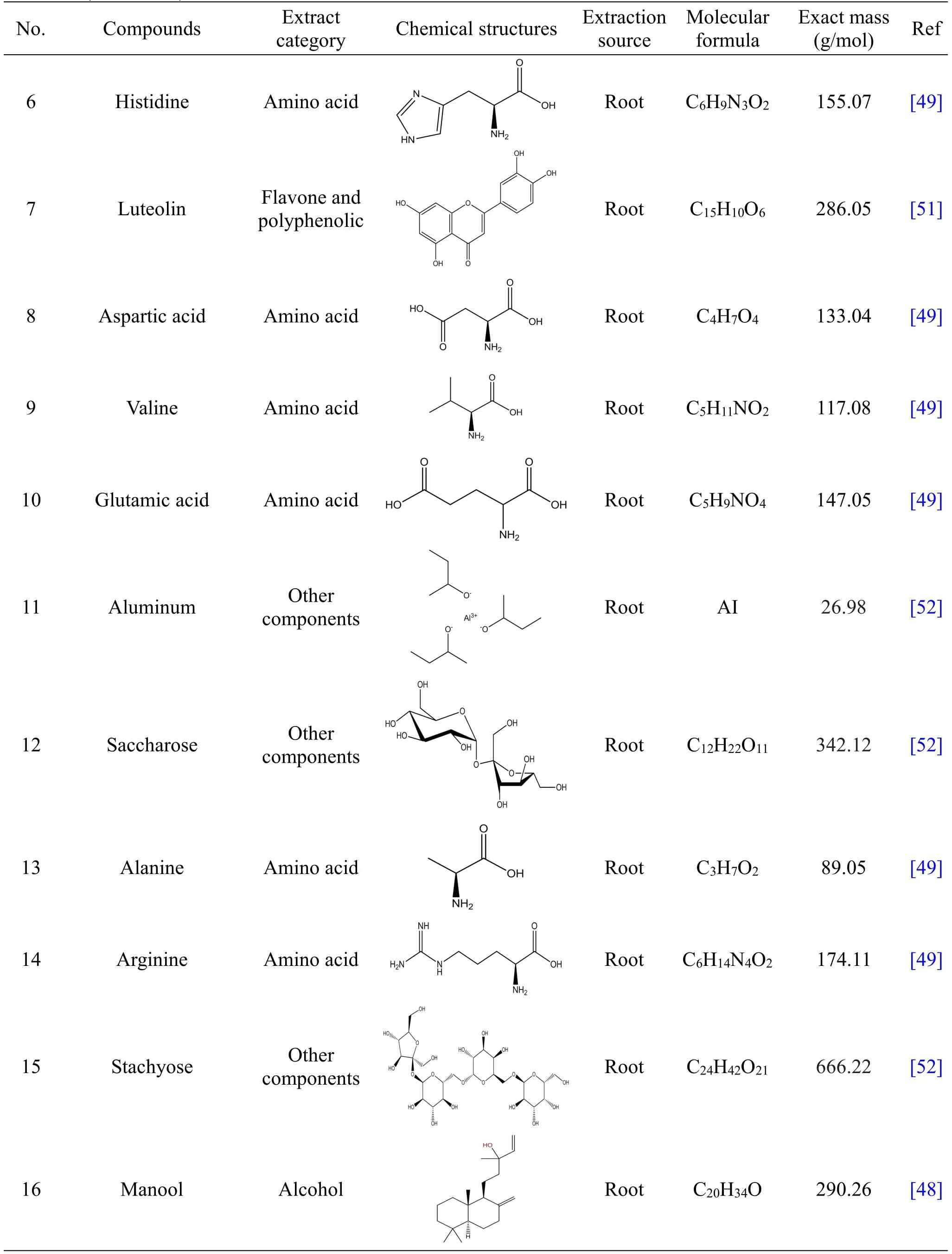
Table 4 Chemical constituents of other compounds(alcohol,essential oils,and ethyl acetate)from SMB extracts.(Continued)
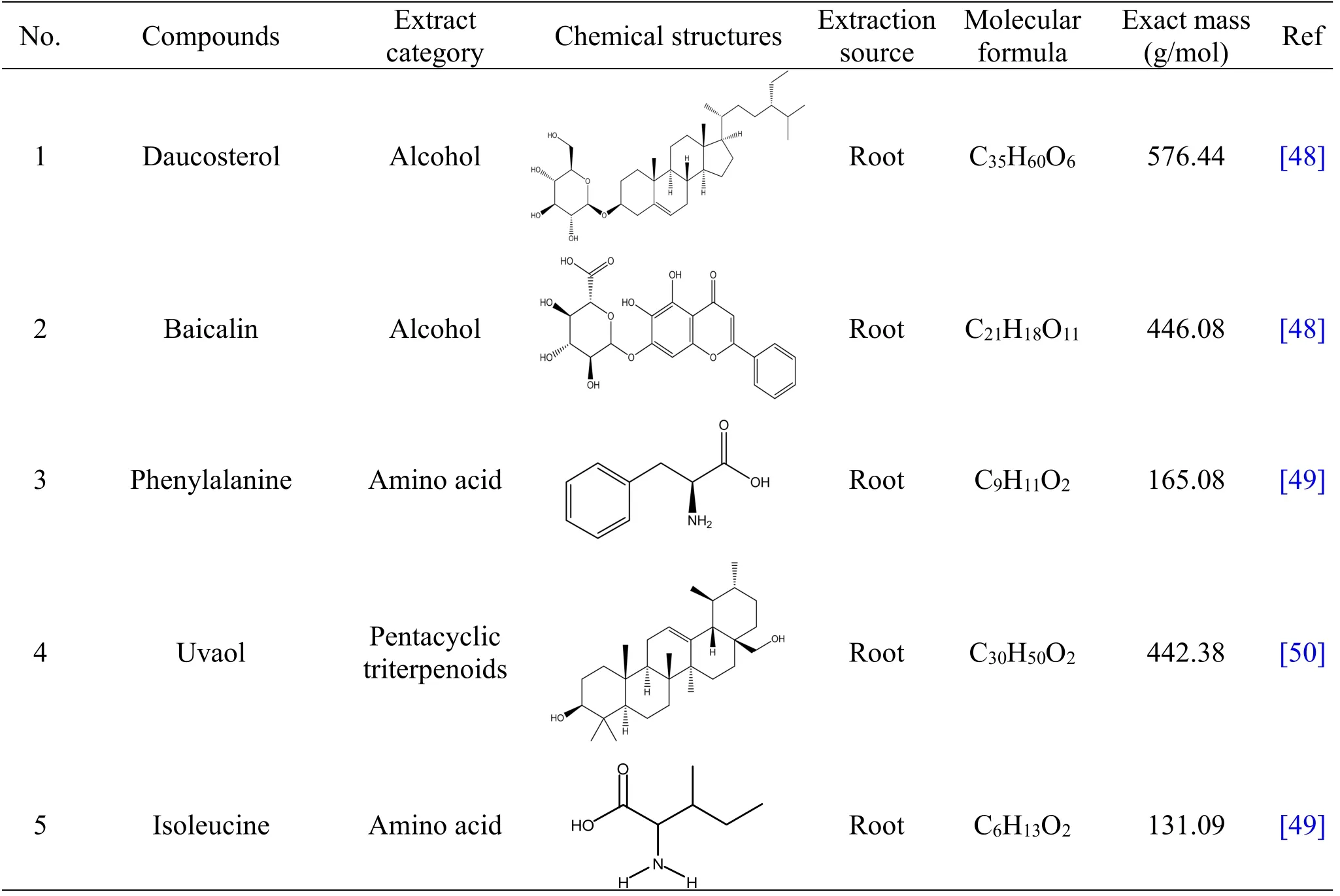
Table 4 Chemical constituents of other compounds(alcohol,essential oils,and ethyl acetate)from SMB extracts
Traditional medicinal uses
The characterization of SMB via its traditional uses,has been employed in traditional Chinese medicine for centuries.In the Qin and Han Dynasty of China(262-202 B.C.E.),the earliest Chinese Materia Medica referred to asShengong’s Classic of Materia Medica,originally documented SMB[15].According to a medical survey conducted on the summarization of SMB actions,blood stimulation and circulation,mind tranquillization,and carbuncles dispersion are the most common uses.However,different inflammatory responses related to insomnia,abdomen lumps,chest lumps,palpitations,skin carbuncle,and pyogenic infection caused by blood stasis are treated with SMB’s processed herbal extracts.With regard to its above-stated activities,SMB is also applied topically.Its actions as an herb extract utilized in numbness of the feet and spinal column stiffness therapeutics were stated in 219 C.E.bySupplementary Records of Famous Physiciansfrom the Han Dynasty(unknown author).Earlier 3rdcentury,Wupu recommended SMB for abdominal and chest inflammation in his bookWupu’s Materia Medicafinished at Wei Dynasty.Thus,in 935-960 C.E.,a manuscript calledSichuan Materia Medicabrought about a concise document on SMB clinical characters and morphologies[16].The broad and substantial documentation of its additional roles was recorded in 1578 C.E.(Compendium of Materia Medica,a Chinese herbology volume written by Li Shizhen during the Ming Dynasty)[17].
A recognized document(Chinese Pharmacopeia)in 2015 mentioned and listed the current SMB pharmacological effects,such as aids in carbuncles dispersion,promoting blood circulation,fatigue,meralgia,and regulating menstrual discharge.The vast increase in SMB clinical application gained international recognition through Sino-foreign cultural exchanges after its pertinent local documentation.Consequently,European,Japanese,and American commodities consisting of herbal extracts of SMB are traded to alleviate blood stasis and enhance circulation.Presently,SMB is among the most historical and commonly used plant materials utilized in the formulation of traditional Chinese formulas,and it is mostly prepared as a tincture or elixir in China for different disease conditions.
Pharmacology
Defensive actions against diabetes mellitus
According to the American Diabetes Association,diabetes is defined as a group of metabolic diseases indicated by hyperglycemia resulting from insulin secretion or action defects.SMB has proven to possess good potency and actions against this condition.Gegen(Radix Puerariae)plant and SMB aqueous extract pair decrease vascular injuries in diabetes[54].SMB exerts pharmacological effects with Honghua(Carthamus tinctorius)coalescence in cardiovascular and diabetic complications[55].Salvianolic acid B could attenuate human umbilical vein endothelial cell cells damage treated with high glucose or high fat via Sirt1[56].Tanshinone IIA ameliorates diabetic cardiomyopathy via Grp-78 suppression and CCAAT/enhancer binding protein homologous protein expression in streptozotocin induced diabetic rat[57].Salvianolic acid B also exerts antidiabetic effects via intrinsic processes,namely endothelial cell apoptosis prevention,oxidative stress alleviation,invigoration of endothelial nitric oxide synthase phosphorylation and adenosine monophosphate(AMP)-activated protein kinase pathway activation[58-60].
Anti-thrombotic action
Thrombosis is the formation of a blood clot,known as a thrombus,within a blood vessel that prevents blood from flowing normally through the circulatory system.The anti-thrombotic actions of SMB include its antioxidative potency regarding vascular endothelial cells in deep vein thrombosis.SMB extracts exert alleviative thrombotic actions by indirectly depressing adhesion molecules or directly scavenging the produced peroxides[61,62].3,4-dihydroxy-phenyl lactic acid and salvianolic acid B possess an inhibitory action on vein thrombosis via either directly scavenging the peroxides produced or indirectly depressing the expression of adhesion molecules in neutrophils in rat membrane[63].Cardiotonic pills containing SMB,Sanqi(Panax notoginseng),and Bingpian(Borneol)suppress the formation of thrombosis,inactivate phospholipase/protein kinase C pathway,and repress platelet aggregation[64].Protocatechuic aldehyde suppresses migration and proliferation of intravascular thrombosis and vascular smooth muscle cells[65].Acetylsalvianolic acid A possesses retrogressive actions in rats with ischemia of the focal cerebrum[66].Danshensu exhibits a dynamic anti-thrombotic activity and an anti-platelet aggregation effect without inducing gastrointestinal adverse events[67].
Anti-inflammatory action
Inflammation is a localized physical condition in which part of the body becomes swollen,hot,reddened,and often painful,primarily due to an infection or injury.However,SMB or its extracts potentiality has proven to possess significant anti-inflammatory activities.Tanshinone extracts of SMB shield colitis gravis actuation in rat contrary to dextran sulfate sodium via repressing toll-like receptor-4/phosphatidylinositol 3-kinase/protein kinase B/mammalian target of rapamycin signaling pathway[68].Dihydrotanshinone-I serves as a cardio-protective constituent utilized in managing cardiotoxicity inflammation induced by doxorubicin via mammalian target of rapamycin-transcription factor-EB-nuclear factor kappa-B pathways[69].Tanshinone IIA hinders in-vivo and in-vitro growth and infection in vascular smooth muscle cells via downregulation of miR-712-5p expression[70].SMB exerts a positive pro-inflammatory action contrary to macrophage activated inflammation via toll-like receptor-2[71].Cryptotanshinone shields dextran sulphate sodium induced colitis gravis in rat via suppressing intestinal injury[72].Salvianolic acid C alleviates apoptosis and damage induced via lipopolysaccharide in human periodontal ligament stem cells by toll-like receptor-4 or nuclear factor kappa-B mechanism[73].Also,diethyl blechnic suppresses lipopolysaccharideinduced inflammation,mainly through myeloid differentiation factor-88 or toll-like receptor-4 and oxidative stress signaling mechanism[74].
Antifibrotic action
Fibrosis,also referred to as fibrotic scarring,is a pathological condition in which connective tissue replaces normal parenchymal tissue to the extent that goes unchecked,leading to considerable tissue remodeling and the formation of permanent scar tissue.Numerous analytical studies have shown SMB’s usefulness and its extracts towards pulmonary and hepatic fibrosis through attenuation,inhibition,or blood circulation enhancement and hepatocytes regeneration.Tanshinone IIA exerts antifibrotic action by enhancing liver functions,attenuating extracellular matrix accumulation,liver injury,hepatic stellate cell activation,and proliferation[75,76].Salvianolic acid B suppress 5’-AMP-activated protein kinase and Smad protein or transforming growth factor-β mediated mechanism[77]and liver fibrosis in mice induced by carbon tetrachloride[78,79].The hot water root extract of SMB hinders lipid peroxidation and hepatic fibrosis in mice activated via obstruction of the biliary[80].Combination of SMB with Huangqi(Astragalus membranaceus)exerts antifibrotic actions via mediating transforming growth factor-β/Smad signaling in myofibroblast[81].SMB extract(injectable)demonstrates hepatic protective effects through diminishing inflammation,apoptosis,and oxidative stress[82,83].Besides,SMB andAstragalus membranaceusextract also inhibit hepatocellular carcinoma progression via suppressing transcription of plasminogen activator inhibitor-1-messenger ribonucleic acid and fibrosis[84].
Anti-ischaemic action
Clinically,ischemia is a severe condition with inadequate blood supply to an organ or part of the body,especially the heart or brain muscles.Thus,SMB and its extracts yield a prospective technique towards ischaemic stroke treatment.Administration of tanshinone causes a significant decrease in brain ischemia and repairs neurological activities in rats[85,86].Compound root extracts of SMB exhibit improve microcirculatory disturbances and target organs’inflammation via reperfusion and ischemia[87].Magnesium lithospermate B extracted from SMB inhibits sodium,potassium,and adenosine triphosphate(Na+,K+-adenosinetriphosphatases)actions and yields anti-ischaemic neuroprotection in gerbils subjected to reperfusion and focal ischemia[88].Also,SMB extracts could reduce blood-c-reactive protein and avert recurrence of ischaemic stroke[89].
Antitumor action
Cancer or tumor occurs as a result of abnormal growth in cell proliferation,thereby attacking surrounding tissues.Several analytical studies have shown the efficacy or potency of SMB and its extracts regarding this disease over the years.Consequently,cryptotanshinone hinders atrophy of muscle in colon adenocarcinoma conditioned medium actuated malignancy cachexia via suppressing the signaling mechanism of signal transducer and activator of transcription 3[90].Dihydrotanshinone impairs mucositis actuated chemotherapy in the intestine and improves microbiota in rats[91].Salvianolic acid B exhibits relevant antitumor effects in proliferation and apoptosis analysis[92].Aqueous SMB extracts also diminish elevated endothelial permeability induced via tumor necrosis factor-α[93].SMB bioactive tanshinones suppress the advancement of in-vitro malignant prostatic cells in rats[94].SMB polysaccharide demonstrates its anti-cancerous effect and increased anti-oxidase actions in rat hepatocellular carcinoma H22-cells bearing mice,namely superoxide dismutase,glutathione peroxidase,and catalase[95].Baicalin,independently or combined with other extracts of SMB,serves as an anti-cancerous agent[96].SMB polysaccharide enhances immune function in gastric cancer rats[97]whereas cryptotanshinone and dihydrotanshinone,SMB derived compounds,are utilized as adjunct therapy alongside with anticancer remedies to improve their treatment effectiveness for colon cancer[98].
Antihypertensive action
World Health Organization defines elevated blood pressure,or hypertension as a condition in which the blood vessels have persistently raised pressure.A combination of SMB andAstragalus membranaceusexhibite an excellent antihypertensive effect that may be driven by the protective effects of the intestinal flora and beneficial metabolites[99].SMB combined with magnesium tanshinoate B decreases elevated blood pressure to the arteries[100].In addition,ligustrazine combination with SMB produces an antihypertensive effect on pregnancy-induced hypertension[101].SMB may avert left ventricular hypertrophy in spontaneous hypertensive mice and significantly suppress collagen composition[102].A formulated drug extract of SMB(Fufang Danshen tablet,China FDA approved number:Z20083347)diminishes pulse rate,systolic blood pressure,and is well-tolerated in hypertensive patients[103].Sodium tanshinone IIA sulfonate exhibits remarkable beneficial action on pulmonary hypertensive patients[104].SMB-water extract exerts a positive effect on renovascular hypertension by suppressing angiotensinconverting enzyme,which is an essential regulatory enzyme of renin-angiotensin system[105].
Defensive actions against renal injury
Renal or kidney injury refers to an abrupt decrease in kidney function,resulting in the retention of urea and other nitrogenous waste products.Hence,an SMB extract(salvianolic acid A)possesses positive inhibitory effect on acute kidney injury via repressing in-vitro and in-vivo inflammation[106].SMB exerts protective effects against renal ischemia-reperfusion via decreasing serum creatinine,blood urea nitrogen,interleukin-6, tumor necrosis factor-α, and malondialdehyde levels,elevates glutathione and antioxidative enzyme effects [107]. Oral administration of tanshinone IIA can improve renal dysfunction associated with chronic kidney disease[108].Additionally,SMB exhibits protection action against renal injury through increasing the action of cytochrome-c-oxidase[109].SMB possesses a defensive effect against renal damage in lead(Pb)exposed mice by reducing kidney accumulated Pb,renal apoptosis,and lipid peroxidation[110].Tanshinone IIA impairs ischemia/reperfusion renal injury via inhibition of myeloperoxidase,inflammatory response, macrophage inhibitory factor,apoptotic-mediating caspase-3,and phosphor-p38 mitogen-activated protein kinase in mice[111].
Anti-hyperlipidemic action
Hyperlipidemia or hyperlipoproteinemia is an abnormally high concentration of fats or lipids levels in the blood.Danhong injection(a Chinese medical product extracted from SMB andCarthamus tinctorius)exerts lipid-lowering actions through considerably diminishing triglyceride,total cholesterol,low-density lipoprotein cholesterol,arteriosclerotic index,fatty acid synthase expression,3-hydroxy-3-methylglutaryl-CoA reductase,messenger ribonucleic acid and elevates carnitine palmitoyltransferase gene and peroxisome proliferator-activated receptor alpha activity[112].Aqueous extract of SMB can ameliorate hyperlipidemia,glucose,and blood fats in mice[113].Also,SMB extract may decrease low-density lipoprotein cholesterol and elevates high-density lipoprotein cholesterol without action on triglyceride[114].SMB andRadix Puerariaeserves as an effective remedy in treating hyperlipidemia induced through high-fat-diet in mice[115].Fufang Danshen drop pill can also diminish total cholesterol and triglyceride level in the blood and alters some hemorheology indices[116].
Actions on neurodegenerative condition
Neurodegenerative condition is an intermittent and hereditary disease identified through continuous impairment,death,and degeneration of a certain number of neurons that are frequently interconnected synaptically.Such disease conditions include corticobasal degeneration,Parkinson’s disease,progressive supranuclear palsy,etc.SMB extract also attenuates rat neuronal pheochromocytoma PCI2-cells and Alzheimer’s disease[117].
Tanshinone IIA breaks down particular endogenous tau protein and hampers tau fibrillation via the ubiquitin-proteasome pathway[118].Salvianolic acid B extract averts apoptosis affected by 6-hydroxydopamine in human neuroblastoma SH-SY5Y cells and yields significant neuroprotective actions on SH-SY5Y cells against amyloid-β protein actuated cell death[119,120].Another analysis recommended SMB to have high anti-Alzheimer’s disease effect and its components as a new remedy source essential for advancing prospective anti-Alzheimer’s disease candidates[121].
Other actions
Tanshinone IIA suppresses transactivation of Tat-actuated human immunodeficiency virus via redox-regulated nicotinamide phosphoribosyltransferase/AMP-activated protein kinase signaling mechanism[122].Salvianolic Acid-B suppresses mouth-foot-hand disease enterovirus-71 replication via improving protein kinase B pathways[123];however,combination of cryptotanshinone andCunninghamellaelegansexhibit anti-neuroinflammatory actions via protective actions via diminishing toll-like receptor-4 mediated mitogen-activated protein kinase mechanism[124].Danqi pill(approved drug number by China FDA:Z11020471,mixture of SMB andPanax notoginseng)could enhance reactive oxygen species activated energetic metabolism dysfunction,sustain functions of mitochondria and ease energy by targeting on retinoid X receptor alpha directly[125].Tanshinone IIA possesses protective effect against severe pancreatitis in rats by suppressing oxidative stress through reactive oxygen species/Nrf2 mechanisms[126].SMB extract(hydroalcoholic)enhances effects of antioxidant enzymes,sperm parameters,and diminished testicular tissue damage and ischemia-reperfusion damage or injury[127].Herb pair of SMB andPanax notoginsengaids in modulating amino acid profiles and serum lipidomics in rats with acute myocardial ischemia[128].Figure 2 shows a schematic illustration of the pharmacological actions of SMB and its extracts or constituents.
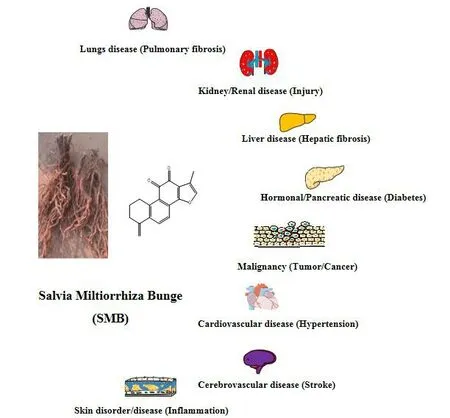
Figure 2 Pharmacological actions of SMB and its extracts or constituents.SMB,Salvia miltiorrhiza Bunge.
Pharmacokinetics
Pharmacokinetic analysis of SMB was mostly carried out on its hydrophilic,lipophilic,and other chemical constituents, namely cryptotanshinone,dihydrotanshinone,etc.Thus,the evaluation of these extracted and isolated SMB ingredients in animal are further highlighted below.The technique known as ultra-performance liquid chromatography-tandem mass spectrometry(UPLC-MS/MS)was utilized to determine the plasma pharmacokinetic assessment of SMB extract in normal and acute renal failure.It was deduced that pharmacokinetic characteristics of the constituents in acute renal failure proved contradictory[129].Moreover,it was indicated that AUC0-t and Cmax studies of cryptotanshinone,tanshinone I,tanshinone IIA(i.e.SMB extract)diminished,whereas there was an elevation in CLz/F of the model group.Thus,AUC0-t and Cmax of the four tanshinones mentioned above,increased in regulation,and reduced in CLz/F regulation,following extracts of water,and ethanol coalescence via intragastric administration.During single and multiple pharmacokinetic doses of cryptotanshinone using rats as a specimen,before intra-gastric administration,the starved rats’blood sample was obtained from fundus venous sinus[130].However,liquid chromatography linked with mass spectrometry(LC-MS)was utilized in deducing cryptotanshinone plasma concentration.The single and multiple cryptotanshinone doses indicated absolute-zero variation proving that in-vivo cryptotanshinone accumulation possesses no uncertainty or danger.
Remarkably,the multi-peak flow time curve and concentration of tanshinone IIA in plasma were efficiently ascertained in rats[131].Nonetheless,before Naoxintong capsule administration,a famous patent traditional Chinese medicine drug containingAstragalusmembranaceus, Chishao (Paeonia lactiflora),SMB,Danggui(Angelica sinensis),Chuanxiong(Chuanxiong rhizome),etc.,(approved number by China FDA:Z20025001)was given orally at different doses such as 1.5,and 0.5 g/kg independently.The concentration of the constituents in plasma were adequately verified,via the procedure known as high-performance liquid chromatography-tandem mass spectrometry(HPLC-MS)/MS[132].Hence,the in-vivo time of activity for T1/2 values of tanshinone IIA and cryptotanshinone to variant constituents was considerably prolonged,as demonstrated analytically.Although,tanshinone IIA profile distribution via gastrointestinal tract(GIT)of mice indicated 0.25,2,and 12 hours homogenate time intervals respectively,after its oral administration.Besides,the GIT level of tanshinone IIA was moderately outstanding[133].
Furthermore,liquid chromatography with diode array detection,tandem MS with electrospray ionization was applied in the identifications of tanshinone-IIA,tanshinone-I,cryptotanshinone,and dihydrotanshinone-I,which lead to the recognition of two(metabolites)four(phase),and one(metabolite)sixteen(phase),before dihydrotanshinone I and tanshinone I biotransformation exhibited outcomes in mice[134].Tanshinone oxidative reactions,hydroxylation,furan-ring cleavage,dehydrogenation,oxidation,hydroxylation,and pyrolysis were the significant tanshinones metabolic pathway outlined.Hence,conjugates of sulfate esterification and glucuronic acid was predominantly carried out in phase II metabolites formation.
Another tanshinone experiment was performed,with regards to intra-hepatic modification and elimination of bile.The evaluation outcome proved that these constituents or extracts,namely cryptotanshinone,tanshinone II,and tanshinone I,might be eliminated via bile in the liver[131].Before intravenous dihydrotanshinone injection,there has been initiation of a procedure or technique termed liquid chromatography tandem MS with electrospray ionization,used in bile samples of rat for metabolites identification,and the outcome also identified(two)metabolites(1)phase,and(one)metabolites(15)phase respectively[135].Nonetheless,before injecting these tanshinones(i.e.tanshinone-I,tanshinone-IIA,shikonin,crypto-tanshinone-I,tanshinone-IIB,sodium tanshinone-IIA sulfonate, and 15,16-dihydrotanshinone-I)intravenously in rats bile,HPLC/MSnwas applied in phase-I for verification or designation of metabolites[136].The research recognized 33 metabolites that recommended dehydrogenation and hydroxylation as a standard procedure for the metabolism of tanshinone IIA,whereas hydroxylation was applied in tanshinone IIB.Although, the observation of tanshinone-I hydroxylated metabolite occurred in liver microsomes of the rats, while observing, tanshinone I-O-glucuronidation took place in urine of the rats[137].However,tanshinone biotransformation in the bile of rat consisting of oxidation,hydroxylation,dehydrogenation,and furan ring cleavage is considered tanshinone-I-phase-I fundamental pathways[136].Q-trap mass spectrometer and HPLC-ultraviolet technique were utilized to influence significant tanshinone I metabolites with the aid of liver microsomes formulation in humans[138].The outcome demonstrates that tanshinones’key biotransformation pathways-I discovered six metabolites via reduction,glucuronidation,and hydroxylation technique or procedure.
Moreover,after sublingual administration of compound Danshen dropping pills,in the plasma of tanshinone IIB metabolites,liquid chromatography linked with MSnmechanism was employed in the analysis[129,139].Tanshinone IIB outcomes indicated the possibility of an in-vivo loss of hydroxymethyl.Another study demonstrated that cryptotanshinone metabolites obtained from bile and urine of mice constitute hydroxylation products of tanshinone-IIA,cryptotanshinone,tanshinone IIA,glutamic acid,and tanshinone IIA coalescence.But the cryptotanshinone elimination rate was less in the rat urine,and more in bile.Furthermore,uridine diphosphate-glucuronosyltransferase 1A9,nicotinamide adenine dinucleotide phosphate;quinone oxidoreductase 1-mediated quinone reduction and subsequent gelation portrayed a significant function in tanshinone IIA pathway of metabolic activity,which was demonstrated in the in-vivo and in-vitro studies[140].Nonetheless,an instant pig model was administered with tanshinone,dehydrogenation of cryptotanshinone occurred in the plasma after liver and blood effects leading to the formation of tanshinone IIA,the primary metabolite[141].Hence,HPLC/(ion trap)-MSnwas wielded in zebrafish for the studies or analysis of tanshinone IIA metabolites that produced dihydroxylation,dehydrogenation,and monohydroxylation as its essential metabolites[142].A different analysis also deduced that tanshinone IIA was a cryptotanshinone metabolite obtained in rats’plasma[143].In addition,tanshinone IIA was stipulated to suppress cytochrome P450 actions of liver microsomes metabolic stability evaluation in rats[144].
Toxicology
SMB has been adequately applied or utilized in hypertension therapeutics caused by pregnancy via angiotensin converting enzyme inhibitors suppression.Its chemical constituents and angiotensin converting enzyme inhibitors employed have been stipulated and illustrated by numerous analysis to effect fetus affiliated toxicity within 13-36 weeks of gestation[145].Consequently,the side or adverse reactions of a remedy/medication known as depsides salt injection obtained from SMB as a constituent include psoriasis,fatigue,headache,liver malfunction,low blood platelet count,and facial flushing could result in a rapid rate of infusion,etc.The administration or constant use of depsides salt injection on beagles for analysis demonstrated its toxicity dose at 320 mg/kg and safety dose at below 80 mg/kg[146,147].Another research also exhibited that SMB injectables at higher doses of 5.76 g/kg per day might lead to peripheral vascular adverse reactions such as vascular endothelial apoptotic cells,endothelial-1,serum nitrate,and vascular leakage magnification[148].Other insignificant adverse reactions of certain medications involve local inflammation,GIT disturbances and pruritus.Currently,SMB and its constituents are commonly applied and prescribed clinically with no critical side or adverse reactions.In addition,more treatment manifestations of SMB ought to be collated for better health evaluation assessment.
Quality control
In-vivo metabolites evaluation of SMB extract or decoction
The purpose of clinical trials,which include absorption,distribution,metabolism,and excretion of SMB extracts or decoction,is simply for the significant understanding of well-being and adverse reactions or effects.An analysis purported that salvianolic acid B possesses tremendous inadequate bioavailability in rats employing HPLC-electrochemical detection technique and eliminated predominantly as methylated metabolites into bile[149,150].Thus,SMB phenolic ingredients analytical determination after oral,intravenous,and hypodermic administration in serum through HPLC-multidimensional or LC-MS have also been stated[151-155].Additionally,it has demonstrated that the rapid distribution of salvianolic acid B or phenolic acids in rats is stored in tissues.In contrast,the kidney is the organ responsible for the major distribution after administering four phenolic acids orally in rats[155].
Analytical techniques application for evaluation of the quality
The assessment of the quality of SMB is commonly associated with the active constituent concentration level.However,the salvianolic acid and tanshinones,characterized as hydrophilic and lipophilic,are regarded as a significant bioactive constituent and,consequently,SMB quality markers.Several types of research or analysis were carried out to recognize the attributable SMB ingredients;thus,the three frequently applied or utilized analytical techniques to determine dominant SMB bioactive components:UPLC-MS/MS,high-performance liquid chromatography-diode array detector(HPLC-DAD),and UPLC discretely[156-159].Furthermore,the method initiated specifically or concomitantly for the designation of hydrophilic or lipophilic attributable SMB ingredients is termed HPLC-DAD.Whereas in SMB hydrophilic and lipophilic ingredients,UPLC and UPLC-MS/MS techniques are used for its quantification simultaneously.Moreover,specific active constituent quantification and differentiation in several SMB preparation batches are assessed or applied by a few representative studies using UPLC-MS/MS.
Chemical fingerprint evaluation
In the year 2000,an organization known as state FDA,responsible for commodities’potency and efficacy,suggested using a chemical fingerprint for evaluations regarding herbal or conventional Chinese medicines.The purpose or aim of such analytical methods was recognized due to origin disparity,chemical profile,accuracy identification,and quality assessment of the herbs or its constituents.The complete chemical profile identification of SMB fingerprint evaluation was disclosed using partial least squares discriminant analysis, UPLC-DAD, HPLC-DAD, principal component analysis,HPLC-MS/MS and hierarchical cluster analysis[160,161].The technique developed for different peak standard observations depending on numerous SMB constituents,includes UPLC-DAD and HPLC-DAD.Nonetheless,the identification of constituents/climax in the method mentioned above chromatograms are narrated or detailed through their attributable fragment ion guidance in LC-MS/MS studies.Besides,the chemo-metric technique is used in assessing and examining attributes of SMB and quality markers.The various SMB bioactive constituents are proposed to possess heterogeneous hypothetical outcomes due to degree alterations via processing procedure.
Conclusion and future perspective
The SMB and constituent applications have posed a remarkable advancement or progression worldwide,especially regarding its clinical analysis,including pharmacokinetics,pharmacological,clinical benefits,and so on.However,over the years,due to limited means in research,its significant activities comprising blood stasis elimination and enhancing blood circulation were recorded in Chinese treatise.It is proven in China with medical trials and background aid to possess fewer adverse effects and safe.Moreover,presently numerous compendiums include well-detailed manuscripts about different herb extracts,categorization,and additional importance such as coronary arteries dilation,blood enhancement flow,myocardial ischemia prevention,etc.Several in-vitro and in-vivo analysis of SMB extracts has demonstrated great potency and effective towards a vast number of disease therapeutics.Hence,to further exploit its full potential uses,consistent and extraordinary evaluation procedures must be carried out,especially towards its constituent extraction,source of extract(flowers,roots,or rhizome),toxicological or adverse reaction assay,dosage form,doses,and its pharmacokinetics.
Furthermore,the analytical assessment of its active constituent pharmacokinetics was observed using an animal model via an intravenous and oral administration route.More studies clarify herbs and their constituent need to be implemented and new techniques for improvement towards detection purposes to allow proper inspection,analytical data collection,and easy methods of isolation for the active ingredients.Also,some constituents of SMB have been applied in the treatment of specific ailments without full understanding or knowledge about its mode of action,etc.Nonetheless,researchers ought to carry out a more holistic examination to evaluate unknown prospective constituents,which would help treat ailments(diabetes,cancer,etc.)affecting people worldwide.
In addition,examining the toxicity or adverse reaction,quality control,mechanisms of action,phytochemistry,and pharmacological actions is required to acknowledge its use medically and enhance its exploration for other purposes.
杂志排行
Traditional Medicine Research的其它文章
- Annual advances of integrative pharmacology in 2020
- Enrichment of the less polar ginsenoside(Rg3)from ginseng grown in New Zealand by post-harvest processing and extraction
- Pharmacological research progress of ursolic acid for the treatment of liver diseases
- System pharmacology-based dissection of the potential effective material basis and mechanism of Xiaoxianxiong decoction for type 2 diabetes mellitus
- Network pharmacology-based approach to investigate the mechanism of Huang-Lian-Jie-Du-Decoction for treatment of type 2 diabetes mellitus
- Study on possible synergistic anticancer cachexia effects of the main active compounds of Radix Sophorae flavescentis
